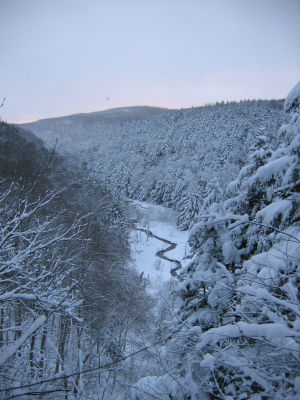Overview
The Forest Legacy Program (FLP) is a partnership between participating states and the USDA Forest Service to identify and help protect environmentally important privately-owned forestlands from conversion to non-forest uses. In order to receive FLP funds, each state must determine areas where the most valuable forestlands face the greatest threats (Forest Legacy Areas), determine criteria for selecting projects to be proposed for funding, solicit and receive input from the public, and seek approval from the Secretary of Agriculture.
 The document that presents the results of these activities is called the Assessment of Need (AON). The Vermont Department of Forests, Parks and Recreation (FPR) is charged with developing the AON and also administers the program for the state. In Vermont, conservation easements with willing landowners are the main tool used by the program, though fee acquisition of strategic parcels also occurs. FLP conservation easements are held by FPR, while fee purchases may be held by a town or FPR. Once the Forest Legacy Area is approved, landowners from towns in the program may then submit tracts or projects to the state to be considered for funding through the program.
The document that presents the results of these activities is called the Assessment of Need (AON). The Vermont Department of Forests, Parks and Recreation (FPR) is charged with developing the AON and also administers the program for the state. In Vermont, conservation easements with willing landowners are the main tool used by the program, though fee acquisition of strategic parcels also occurs. FLP conservation easements are held by FPR, while fee purchases may be held by a town or FPR. Once the Forest Legacy Area is approved, landowners from towns in the program may then submit tracts or projects to the state to be considered for funding through the program.
Vermont’s first AON was approved in 1994. By March 2008, 20 projects approaching 53,000 acres were conserved with $11.2 million FLP dollars and additional matching funds. Among these was the first approved FLP project in the country at Cow Mountain Pond in the Town of Granby. The importance of the Forest Legacy Program to forest conservation efforts in Vermont cannot be underestimated. Although just one program among many, the FLP funds made available for projects throughout the state have made possible huge strides toward implementing comprehensive conservation strategies across the landscape.
AON Document Text
The new 2010 AON (text only) was developed using new information that has been generated about Vermont’s forests over the past decade. Improvements in spatial technology capabilities now allow for a more thorough assessment of Vermont’s forest resources and threats to their conversion. Through the ability to assign different weights to forest values, spatial technology is facilitating the display and designation of priority forestlands. The forest values used for the analysis reflect the goals of the FLP in Vermont as articulated in the AON.
AON Maps
The single Forest Legacy Area (map) proposed for Vermont in this AON encompasses approximately 2.6 million areas and is a change from the 3.3 million acres in three Areas designated in the 1994 AON. The forestlands selected for each AON were found to hold the highest potential for the forest values deemed most important for the Vermont Forest Legacy Program at the time. For the draft 2008 AON, the values deemed most important in descending order are the (large) size of a forest block, productivity of soils, and ecological resources including wildlife and habitat benefits. A preliminary map showing these was created for this document. The designation of a single Forest Legacy Area will be beneficial for administration of the program as well.
Project Selection Criteria
The AON presents the criteria used to select projects that will be recommended for funding by the program. The Vermont Forest Stewardship Committee, whose members represent many interests and organizations throughout the state, takes the lead in ranking projects. The minimum criteria for participation in the program are as follows: the project must be in the Forest Legacy Area; must have local and regional support; must be at least 100 acres and being part of larger area with similar goals is preferred; projects with less than 10% in non-forest uses may be considered; dispersed pedestrian public access must be guaranteed; and a Forest Stewardship Plan must be approved by the State Forester. Other criteria to be considered include the following: the primary purposes of the parcel are related to forestry and ecological conservation; secondary purposes of the parcel enhance scenic, public recreation, riparian/hydrologic, and cultural/historic resources; there are threats to conversion of the parcel to other uses; the parcel has relevance to the broader landscape; and the degree to which the project is ready.
Public Input
Besides the ongoing involvement of the Vermont Forest Stewardship Committee, whose members represent many interests and organizations throughout the state, in developing the AON, the public is invited to participate directly in the process. Each of the 11 regional commissions is hosting a meeting for people to learn about and comment on the AON. Each town in the proposed Forest Legacy Area will be given the opportunity later this year to decide if it wants to be in the program.
